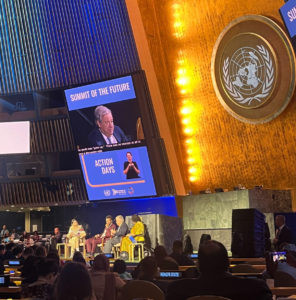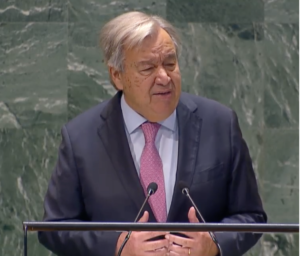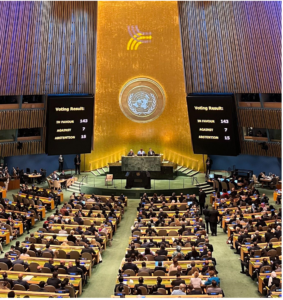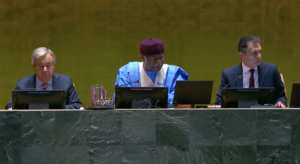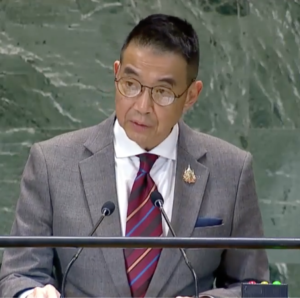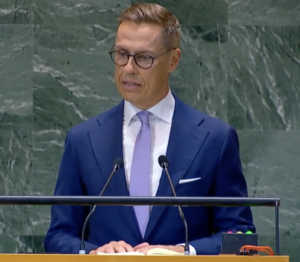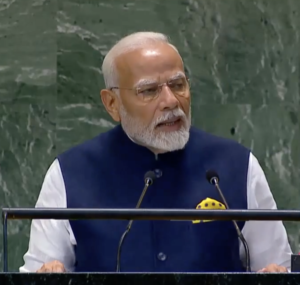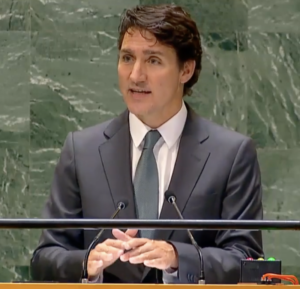What was the Summit of the Future, and what actually happened during this “once-in-a-generation” event? This event report will summarize the Summit itself, the outcome of the Summit, and the major reform themes put forth by Member States during the Summit’s plenary meetings.
Table of Contents:
1. Introduction — What was the Summit of the Future?
2. What was the outcome of the Summit of the Future?
3. What Kinds of Reforms Did Member States Propose?
3.1 Reform Global Financial Architecture
3.2 Reform the United Nations Security Council
3.3 Reform Digital Technology Infrastructure
3.4 Reform Climate Change Commitments
4. Conclusion — What is the Way Forward?
1. Introduction — What was the Summit of the Future?
The Summit of the Future (SOTF) was a high-level, two-day event held on September 22 and 23, 2024 at the United Nations Headquarters in New York City, USA, ahead of the 79th United Nations General Assembly “high-level” week. The purpose of the Summit was to bring together world leaders to revitalize their commitment to multilateralism and international commitments, including the 2030 Sustainable Development Agenda, in order to forge a path forward that will ensure a more peaceful and secure world for both present and future generations.
As UN Secretary-General Antonio Guterres shared ahead of the Summit, “We cannot create a future fit for our grandchildren with a system built by our grandparents.” The SOTF also served as a “once-in-a-generation” opportunity for global leaders to rethink outdated UN structures put in place at the end of WWII almost 80 years ago, many of which no longer reflect the political, economic, and social realities of the present day. This event report will analyze the statements of Member States during the SOTF Plenary Meetings into reform themes, namely reform of:
- Global financial architecture, including debt and interest restructuring;
- The United Nations Security Council (UNSC), including the abolition of the veto power and representation of additional regions;
- Digital technology infrastructure, to bridge the digital divide and ensure Artificial Intelligence (AI) regulation; and
- Climate crisis commitments, including access to climate financing and sustainable development as well as reparations for Member States most affected but least responsible.
As suggested by Secretary-General Guterres following adoption of the SOTF’s Pact for the Future, the SOTF was held at a crucial moment, precisely when our world seems to be “going off the rails.” The United Kingdom noted that conflicts are ongoing in over 30 places around the world, more than any time since 1945.
Given that these conflicts include members of the the five permanent members of the UNSC (the P5) who have abused their veto power to promote the interests of themselves or their close allies, including Russia’s territorial aggression against Ukraine and the United States’ unequivocal support for Israel’s plausible genocide against Palestinians, the SOTF also served as an opportunity to mend eroded trust and recommit to working together for the interests of the collective international community rather than for a single Member State.
2. What was the outcome of the Summit of the Future?
The SOTF ultimately resulted in the adoption of the Pact for the Future (A/79/L2), as well as the Global Digital Compact and the Declaration on Future Generations as annexes. Five revisions of the Pact were circulated and debated among Member States before the final version was eventually adopted. The Pact contains five chapters, namely:
- Sustainable development and financing for development
- International Peace and Security
- Science, Technology and Innovation and Digital Cooperation
- Youth and Future Generations
- Transforming Global Governance
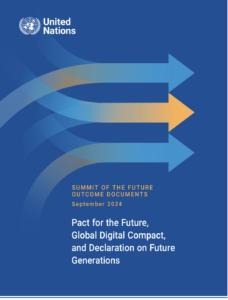
Summit of the Future Outcome Documents — the Pact for the Future, Global Digital Compact, and the Declaration on Future Generations
Though the SOTF was held to encourage multilateralism and cooperation on international commitments such as the Pact for the Future, the final outcome document was almost not adopted due to a lack of consensus headed by the Russian Federation. In particular, the Russian Federation claimed that the Pact was hypocritical since no meetings with negotiations breaking down the Draft Pact paragraph by paragraph were held, and thus the final outcome was a “major defeat of United Nations sovereignty” in that only “one group of countries” decided what the document should ultimately look like.
In protest of the Draft Pact (A/79/L2), on the morning of the Pact’s anticipated adoption, the Russian Federation submitted an amendment (A/79/L3) sponsored by Belarus, the Democratic People’s Republic of Korea, Iran, Nicaragua, and the Syrian Arab Republic, emphasizing that the principle of non-interference in the internal affairs of Member States be protected in accordance with international law. In response, on behalf of the African Group, the Democratic Republic of the Congo introduced a motion that no action be taken on the Draft Pact (A/79/L2).
Following a democratic vote by the General Assembly, the Congo’s motion that no action be taken on the Draft Pact (A/79/L2) was ultimately adopted, with 143 in favor of the motion of no action, 7 against the motion of no action (Belarus, Democratic People’s Republic of Korea, Iran, Nicaragua, Russian Federation, Sudan, Syria), and 15 abstentions (Algeria, Bolivia, China, Cuba, Iraq, Kazakhstan, Kiribati, Lao, Malaysia, Maldives, Oman, Pakistan, Saudi Arabia, Sri Lanka, Thailand).
As a result, the General Assembly democratically decided that the Russian Federation’s proposed amendment would not be considered in the adoption of the Draft Pact (A/79/L2).
Following the vote of no action, the Draft Pact (A/79/L.3) was ultimately adopted by consensus without a vote, along with its annexes, officially becoming a non legally-binding UN resolution. In the General Assembly Hall for the next two days, each Member State was provided five minutes for their high-level representative, including dozens of Heads of State, to present a statement reflecting their State’s position on and/or commitments to the Pact for the Future and its annexes. This event report will analyze the statements of Member States according to major reform themes below.
3. What Kinds of Reforms Did Member States Propose?
3.1 Reform Global Financial Architecture
A core demand of economically developing Member States struggling with debt and interest payments, many of which were previously colonized and had their resources, land, and people exploited by Member States considered economically developed today, is reform of global financial architecture.
As encapsulated by Secretary-General Guterres during his opening statement following the Pact’s adoption, the global financial architecture used today is an outdated structure developed when the global economy was 1/12 of its current size and when most Member States of the United Nations today were under colonial domination of other Member States. As a result, Secretary-General Guterres emphasized that the current global financial architecture does not provide an adequate “safety net” that developing States require, especially to ensure that the most vulnerable Member States can pursue and effectively implement the Sustainable Development Agenda.
During their statements, UN Member States reiterated and expanded upon the Secretary-General’s concerns:
His Excellency John Briceno, Prime Minister and Minister of Finance, Economic Development and Investment of Belize, retold that global financial architecture was built during a bygone era and therefore is not adequate to address the needs of voices on the margins, including youth, women, Indigenous peoples, and countries like his own including Small Island Developing States (SIDS).
Rather than funding sustainable development and social security policies in one’s own country, His Excellency Joseph Nyuma Boakai, President of the Republic of Liberia, revealed that the vast majority of economically developing countries are compelled to spend their money on debt, with interest payments four times greater than a few years ago. In consequence, His Excellency Brice Clotaire Oligui Nguema, Transitional President of Gabon, stressed that reform of global financial architecture must include debt and concessional financing opportunities.
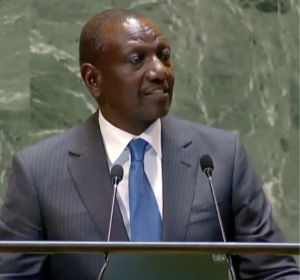
His Excellency William Samoei Ruto, President of the Republic of Kenya and Commander-in-Chief of the Defence Forces, photo from UN Web TV
His Excellency William Samoei Ruto, President of the Republic of Kenya and Commander-in-Chief of the Defence Forces, urged Member States to reject outdated systems and reimagine international cooperation that works for all eight billion people, including a redesigned global financial system. He explained that economically developing countries like his own, especially in Africa and the Global South more generally, are facing severe funding shortages that continue to widen, demonstrating the need for global financial system overhaul. President Ruto further opined that the only way the UN can close the Sustainable Development Goal (SDG) gap is with debt restructuring and more support for sustainable development.
His Excellency Nangolo Mbumba, President of the Republic of Namibia, reiterated that the only way to guarantee that all UN Member States can effectively implement the SDGs is through reform and innovation of global financial architecture. In addition, Her Excellency Fiamē Naomi Mata’Afa, Prime Minister and Minister for Foreign Affairs and Trade of the Independent State of Samoa, explained that reforming global financial architecture to address debt relief would also correct deeply entrenched imbalances, giving breathing space to economically developing countries, including SIDS currently dealing with the impacts of economic instability, climate change, and conflict.
3.2 Reform the United Nations Security Council
In light of the 30+ ongoing conflicts raging around the world today, demonstrating the UN’s failure to preserve peace and security, virtually all UN Member States, including the P5, demanded reform of the UNSC.
Following the Pact’s adoption, Secretary-General Guterres claimed that the UNSC is an outdated UN mechanism established following WWII in 1945, when the UN only had 51 Member States, almost a third of today’s 193 Member States. With the sheer number of ongoing conflicts, in addition the lack of international cooperation and adherence to UN decisions, Secretary-General Guterres warned that the UNSC is continuously losing legitimacy, presenting grave danger to the security of our current and future world.
During their statements, UN Member States reiterated and expanded upon the Secretary-General’s concerns:
His Honorable Nangolo Mbumba, President of the Republic of Namibia, recalled that when the UN was established in the world of 1945, the rubric of “we the peoples” as defined in the UN Charter was drastically different from in the year 2024. For this reason, he stressed that leaders must come together and forge a brighter tomorrow, including by reforming the UNSC.
His Excellency Maris Sangiampongsa, Minister for Foreign Affairs of Thailand, communicated his country’s full commitment to UNSC reform and stressed that this reform is necessary so that the “United Nations represents the interest of all countries.”
Many Member States took a step even farther to discuss and condemn the politicization of the UNSC’s veto power by the P5 to promote their own interests rather than the interests of the international community, particularly by Russia to permit its territorial aggression against Ukraine and by the United States to permit its ally Israel to undergo settler occupation and violations of international humanitarian law against Palestinians in Gaza.
For example, His Excellency Alar Karis, President of the Republic of Estonia, reiterated the need to reform the UNSC by referencing Russia’s constant disregard for the UN Charter and abuse of its veto right, which has allowed Russia to shield its crimes in the UNSC. Likewise, His Highness the Crown Prince Sheikh Sabah Khaled Al-Hamad Al-Sabah of Kuwait noted that the United States has allowed double standards and the “rules of the jungle” to prevail in the UNSC with its continuous support for its ally Israel, a Member State which he stated has killed 42,000 in a genocide in Palestine, most of whom are women and children.
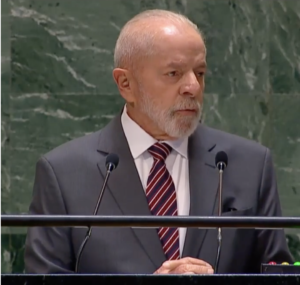
His Excellency Luiz Inácio Lula Da Silva, President of the Federative Republic of Brazil, photo from UN Web TV
His Excellency Luiz Inácio Lula Da Silva, President of the Federative Republic of Brazil, claimed that every time the UNSC applies double standards or fails to act to address conflict, seeming to reference the conflicts fueled by vetoes by Russia and the United States, UNSC legitimacy shrinks. As a result of the UNSC’s shrinking legitimacy, His Excellency Gabriel Boric Font, President of the Republic of Chile, demanded that Member States change the rules of UNSC to adapt to a world reflective of today. He posed the question to Member States, “If we do not change here at the UN, how can we then ask our own people to change?”
While change to the UNSC was widely agreed upon, Member States varied in what they believed UNSC reform should actually look like.
To address the politicization and abuse of the P5’s veto power, Member States without veto power widely agreed that there should be limitations on the veto, including His Excellency Jonas Gahr Store, Prime Minister of Norway and the representative of Austria. Some Member States, including His Excellency Alexander Stubb, President of the Republic of Finland, even suggested complete abolition of the veto power as a whole.
Finland in particular put forth the most concrete and progressive proposals to UNSC reform, which received wide support from Member States as exemplified by an interrupted applause during his statement. These reforms include:
- Adding five new permanent members to the UNSC (one from the Latin American/the Caribbean region, two from the African region, and two from the Asian region);
- Scrapping the veto power of permanent and nonpermanent UNSC members; and
- Suspending the voting rights of a UNSC member if that member blatantly violates the UN Charter.
Representation of new or more Member States in the UNSC to better reflect the world today was a widely spoken demand, including by the P5. His Excellency William Samoei Ruto, President of the Republic of Kenya and Commander-in-Chief of the Defence Forces, emphasized that adding an African representative as a permanent member in the UNSC is essential to UNSC reforms. Austria’s representative supported this proposal, urging leaders to pledge more representation in the UNSC for underrepresented regions and to rectify African injustices.
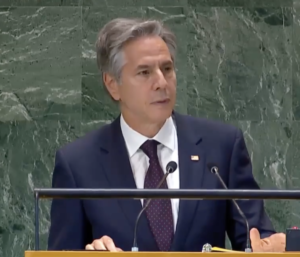
His Excellency Antony J. Blinken, Secretary of State of the United States of America, photo from UN Web TV
The United States, the United Kingdom, and France, three of the five permanent members of the UNSC with veto power, all agreed that the UNSC should be reformed. His Excellency Jean-Noël Barrot, Minister for Europe and Foreign Affairs of France, proposed that the UNSC should be expanded to include African representation among the permanent members. His Excellency Antony J. Blinken, Secretary of State of the United States of America, went even further on the topic of UNSC expansion, suggesting the addition of two permanent seats for Africa, one rotating seat for Small Island Developing States, and permanent representation for Latin America and the Caribbean, as well as permanent seats for India, Germany, and Japan.
Though popular, mere expansion of the UNSC was not perceived as an “end all be all” answer to UNSC for many Member States. For instance, Her Excellency Gordana Siljanovska-Davkova, President of the Republic of North Macedonia, opined that she does not believe that enlarging the UNSC by itself would provide a greater guarantee for peace and security in the world. It is for this reason that many Member States, including Finland, suggested expansion in addition to scrapping UNSC veto power.
3.3 Reform Digital Technology Infrastructure
With technological advancement increasing more rapidly than ever, including with the recent development of Artificial Intelligence (AI), Member States recognized both the necessity of harnessing the potential of technological innovation as well as regulating technology to prevent abuses of it. Secretary-General Guterres noted in his opening speech following the Pact’s adoption that these pros and cons are addressed directly in the Pact’s annex, the Global Digital Compact, which serves the purpose of ensuring that technology is utilized to benefit everyone. Though not legally-binding, the Global Digital Compact is a particularly important document because it initiated dialogue on AI regulation within the UN and is the first universally adopted agreement on global governance of AI.
During their statements, UN Member States reiterated and expanded upon the Secretary-General’s concerns:
In reference to the global digital divide, His Excellency Peter Pellegrini, President of the Slovak Republic, put forth that everyone deserves an equal starting line with digital technology no matter the Member State they come from. When digital technology is accessible to all, His Excellency Ki-Hwan Kweon, Deputy Minister for Multilateral and Global Affairs of Korea, proclaimed that science, technology, and innovation can be harnessed to make the world a better place and advance human rights.
His Excellency Narendra Modi, Prime Minister of the Republic of India, reiterated the positives of technology in connecting humanity, and India’s willingness to share its successful digital public infrastructure with the entire world, especially the Global South. On the flip side, he also noted that technology is emerging as a new conflict threatening global security, and therefore “global action must match global ambition.” President Modi stressed that there is a need for balanced regulation of technology at the global level to ensure its safe and responsible usage, while simultaneously protecting national sovereignty.
Many other Member States similarly viewed technology as a two-sided coin. For instance, Her Excellency Ohood Bint Khalfan al Roumi, Minister of State for Government development and future of the United Arab Emirates, submitted that modern technology should be used properly to ensure a safe digital future while also respecting tolerance and cooperation; His Excellency Maris Sangiampongsa, Minister for Foreign Affairs of Thailand, put forth that advancements in technology have the ability to bring the world together but disinformation also has the ability to push us all apart; and Austria’s representative communicated that while new technology can empower future generations, there must be regulations of autonomous weapons system and other AI mechanisms.
3.4 Reform Climate Crisis Commitments
With the adoption of the 2030 Sustainable Development Agenda back in 2015, and the fact that the world collectively has only met 17 percent of SDG goals with less than six years until the 2030 deadline, the climate crisis, as well as climate crisis commitments that were or were not upheld, were largely discussed by Member States. As opened by Secretary-General Guterres in his statement after the Pact was adopted, though the climate crisis has destroyed and continues to destroy lives and communities, Member States have not listened — fossil fuels continue to be used and emissions continue to rise.
During their statements, UN Member States reiterated and expanded upon the Secretary-General’s concerns:
While war and conflict are often perceived as the greatest threats to world security, His Excellency Arnoldo Ricardo Andre Tinoco, Minister for Foreign Affairs of Costa Rica, posited that climate change is the greatest threat for future generations and that collective action is necessary to address it. Unfortunately, the threats of climate change are not felt equally around the world, and as a result, as put forth by His Excellency Surangel S. Whipps, President of the Republic of Palau, those Member States who are the least contributors to climate change face the greatest risk, forced to confront a global crisis they had little hand in creating.
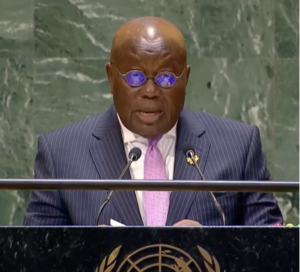
His Excellency Nana Addo Dankwa Akufo-Addo, President of the Republic of Ghana, photo from UN Web TV
In particular, His Excellency Nana Addo Dankwa Akufo-Addo, President of the Republic of Ghana, pointed out that Africa is one region that contributes the least to climate change but must deal with it the most. He explained that Africans are “told to adapt and be resilient,” but questioned, “how do farmers adapt and be resilient when they cannot predict the climate?”
Another especially vulnerable population to the climate crisis are SIDS, including the Federated States of Micronesia and the Independent State of Samoa. For the survival not just of these islands’ land but also of their people and their culture, SIDS urged economically developed Member States with the resources to mitigate climate change in their own countries to address the climate crisis with urgency and to contribute to reparations funding.
Some of these economically developed Member States took this call seriously. For example, His Excellency Justin Trudeau, Prime Minister of Canada, reiterated that climate change does not stop at borders and committed Canada to an emissions ceiling and a $5 billion contribution to fight climate change, which he believes “rich countries” have a “duty” to address. Her Excellency Penny Wong, Minister for Foreign Affairs of the Commonwealth of Australia, also referenced the idea of duty by promoting climate resilience debt clauses to help developing countries build economic resilience in the face of climate change and other shocks. His Excellency David Lammy, Secretary of State for Foreign, Commonwealth and Development Affairs of the United Kingdom of Great Britain and Northern Ireland, reiterated the UK’s commitment to urgent action on the climate crisis through aiming for clean power by 2030 and protection of 30 percent of the UK’s land and water.

Niria Alicia Garcia, an Indigenous youth representative from the United States, photo from UN Web TV
Niria Alicia Garcia, an Indigenous youth representative from the United States, urged economically developed countries most responsible for climate change to do even more by cutting their military budgets and allocating this money instead for climate solutions, reparations for losses and damages to Indigenous people, and implementation of the SDGs.
- Conclusion — What is the way forward?
With the SOTF now a Summit of the past, it is up to Member States to uphold international commitments made during their statements in the Plenary Meetings as well as in the adopted text of the Pact for the Future and its annexes. The United Nations can only function effectively to ensure a peaceful and secure world when Member States are willing to work together, not for their own benefit, but for the benefit of the international community as a collective. Member States must make this change and agree to cooperation for promotion of the lives of present day as well future generations. The future of the United Nations, and our world more generally, depends on it.





